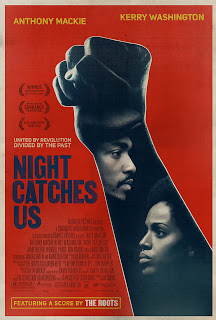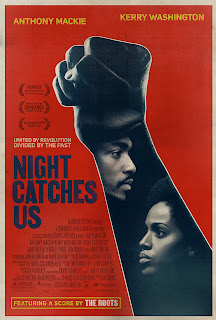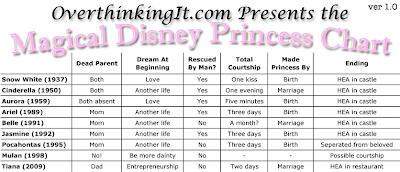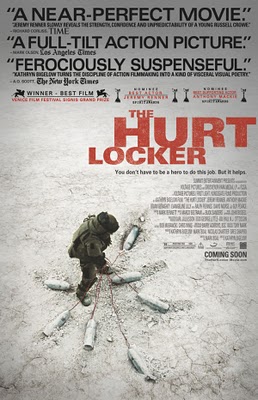Since the first Academy Awards ceremony in 1929, separate acting Oscars have been presented to men and women. Women at that time had only recently won the right to vote and were still several decades away from equal rights outside the voting booth, so perhaps it was reasonable to offer them their own acting awards. But in the 21st century women contend with men for titles ranging from the American president to the American Idol. Clearly, there is no reason to still segregate acting Oscars by sex.
Tag: Women Film Directors
Ripley’s Pick: ‘Tiny Furniture’

Guest Writer Wednesday: Night Catches Us
This guest post first appeared at Arielle Loren, daily musings for ladies and curious men.
Seeing My Reflection In Film: Night Catches Us Struck a Chord With Me
Based in Philadelphia, Night Catches Us tells the story of two former black panthers trying to re-establish life after leaving The Party and the death of a fellow panther years ago. While the central plot revolves around these two characters’ lives, Hamilton integrates into the film historic footage of the Black Panther Party. As this era of black history often is pigeonholed to radicalism, Hamilton truly humanizes The Party through several scenes of police brutality, corruption, and community gatherings. For instance, Washington’s character, Patricia, would raise money to pay the legal fees for her less fortunate clients and feed every child on the block even when she couldn’t pay her light bill.
This sentiment of “community first” is the history with which I identify and the one that I wish we could spread to more mainstream screens. While watching this film, I saw my reflection. From Washington’s afro to her desire to serve her community, I felt hope again for the half-baked images rummaging through mainstream black film. Night Catches Us only is playing in select theaters, BUT you can rent it on iTunes and On Demand via Comcast. Thus, there’s no excuse not to support this film; we’ve got to support the films that we want to see in the mainstream.
Check out the trailer for Night Catches Us below and if you haven’t seen the film, view it on iTunes. Tell me, how can we get more films like this onto the big screen?
The Fat Body (In)Visible
Rabin describes the Fatosphere as follows:
She continues:
Quotes from the documentary: Keena, on Fat Acceptance: Fat acceptance is just accepting your body where it is at. Whether you’re bigger or you’re smaller. Just accepting what it is, your arms, your double chin, your thighs, and just not worrying about how other people may view you.The bloggers’ main contention is that being fat is not a result of moral failure or a character flaw, or of gluttony, sloth or a lack of willpower. Diets often boomerang, they say; indeed, numerous long-term studies have found that even though dieters are often able to lose weight in the short term, they almost always regain the lost pounds over the next few years.
Fat acceptance bloggers contend that the war on obesity has given people an excuse to wage war on fat people and that health concerns—coupled with the belief that fat people have only themselves to blame for being fat—are being used to justify discrimination that would not be tolerated toward just about any other group of people.
Jessica, on Fat Acceptance: Fat acceptance is just the radical idea that every body is a good body and that regardless of your shape or your size that you deserve just as much respect as the next person.
Guest Writer Wednesday: Film Review Roundup
In lieu of a guest review this week, we’re posting links to reviews of a few women-centric films we haven’t yet discussed at Bitch Flicks. Enjoy!
… what finally—and deeply—disappointed us about the film, despite the splendid performances and some pitch-perfect moments of dialogue, were what felt like multiple failures of imagination in its depictions of lesbian sexuality, long-term partnership, and queer family-building. In the end, to use a metaphor in keeping with the film’s upscale SoCal look and value system, The Kids Are All Right opts to put new wine in an old narrative bottle, and the result is a vintage that looks good but leaves a nasty, corked aftertaste.
… the film gratifies the straight male fantasy that what every lesbian needs is a good roll in the hay and presents lesbian relationships as cheap imitations of the worst heterosexual marriages: like them in being riven by conflict, frustration, and inequality, unlike them in lacking the almighty penis …
The film offers an extraordinary portrait of the ways class and gender intersect, revealing how the patriarchal Dolly clan abuses not only drugs, but also its female family members. As such, the narrative offers a lesson about the feminization of poverty, illuminating how poverty’s vice is harder to escape and more likely to ensnare when one is female.
… this gem of a feminist film has been attacked for the very thing that makes it so unique and so rare: its understated, implicit feminist narrative that rails against patriarchy, violence against women, cold-hearted capitalism and militarism, as well as critiquing the insidious and complex ways females are framed first and foremost as objects for male use and abuse.
This wonderful, hilarious, subversive film is a smart, witty smackdown to the slew of “dweeby teenaged boys on a quest to lose their virginity” movies we’re currently under barrage from, not to mention the general unfairness of how the universe treats women who own their sexuality. Easy A overtly shames the slut-shaming of our culture, the bizarre pressures that tells us girls and women that we must be sexy all the time, but for Christ’s sake, don’t actually have sex—except under certain strict conditions—unless you want to be labeled a slut, and humiliated for it.
… As satire goes, this is brilliant stuff. As an exploration of the tangled web of popularity and individuality teenaged girls have to navigate, and do so at more peril than boys do, it’s damn nigh unparalleled. More’s the pity.
Releasing on DVD: Tuesday, March 16
However, Matthew Belinkie at Overthinking It posts an interesting defense of The Princess and the Frog, arguing that even though it maintains traditional Disney Princess elements, it still manages to do things a little differently, in a good way. Definitely check out his article, and his Magical Disney Princess Chart below!
Oh Suicide Girls. Feminist? Anti-feminist? Since they burst on the scene in 2001, these women have certainly stirred up debate throughout the feminist community. From Megan Jean Harlow’s article, “Suicide Girls: Tattooing as Radical Feminist Agency,” to Wired’s 2005 article, “SuicideGirls Gone AWOL,” which reported that 30 models quit because “its embrace of the tattoo and nipple-ring set hides a world of exploitation and male domination” … well, what’s a feminist to do? If you’re interested, check out the new documentary Suicide Girls: Guide to Living, which releases on DVD today. You can also watch the trailer here.
Of Veiled Voices, a documentary about feminism in Islam, Margot Badran writes, “The film, the first of its kind…is not to be missed by any who wish to enter the world of contemporary Islam with its lively gender dynamics being refashioned under our very eyes.” And, contributing editor Mata H. over at BlogHer writes about the film as follows:
This grassroots movement of women establishing themselves as teachers of Islam may seem like a non-event to the Westerner used to female clergy, female teachers, religious and secular classes and worship where the two sexes sit next to each other. But in most parts of the Arab world, the realities of the West are as foreign to them as their realities are to us. And as Huda’s daughter says, all Americans are not George Bush, and all Arabs are not Osama bin Laden.
You can watch a trailer and read an interview with the producer/director Brigid Maher here.
For those of you who didn’t get to see Lesley Stahl’s full 60 Minutes interview with Kathryn Bigelow, it’s being released on DVD today. I’m sure many have seen clips of the interview, and Jezebel also covers it in good detail.
I don’t know much about the following films, but each of them focuses on women, and the stories appear to be interesting. If you see them (or have already), let us know what you think!
Broken Embraces
from amazon.com (this looks a little sketchy from the description): A luminous Penélope Cruz stars as an actress who sacrifices everything for true love in Broken Embraces, Academy Award -winning filmmaker (2003, Best Writing, Original Screenplay, Talk to Her) Pedro Almodóvar’s acclaimed tale of sex, secrets and cinema. When her father becomes gravely ill, beautiful Lena (Cruz) consents to a relationship with her boss Ernesto (José Luis Gómez), a very wealthy, much-older man who pays for her father’s hospitalization and provides her a lavish lifestyle. But Lena’s dream is to act and soon she falls for the director of her first film – a project bankrolled by her husband to keep her near. Upon his discovery of the affair, Ernesto stops at nothing to ruin Lena’s happiness.
Paris
from amazon.com: From Cédric Klapisch the award-winning writer/director of L AUBERGE ESPANGOLE comes a deliciously intimate new valentine to The City Of Lights featuring an all-star cast that includes Oscar®-winner Juliette Binoche (THE ENGLISH PATIENT), Romain Duris (THE BEAT THAT MY HEART SKIPPED), Mélanie Laurent (INGLORIOUS BASTERDS) and François Cluzet (TELL NO ONE). It s the story of a young Moulin Rouge dancer (Duris) awaiting a heart transplant, his single-mother/social worker sister (Binoche), and their rediscovery of the life, laughter and love that hides within every balcony, apartment window, street corner and market stall. These are the stories of the middle class and bourgeois, immigrants and students, fashion models and homeless, and all the lovers and strangers whose paths could only cross and whose worlds are about to change forever in PARIS.
Bandslam
from amazon.com: Not just another by-the-numbers teen-angst movie, Bandslam is a joyful expression of pop exuberance, with an unexpectedly thrilling (and retro) soundtrack and numerous moments of visual excitement. Actor-turned-director Todd Graff brings stylish imagination and heart to this story of a much-taunted and beleaguered kid named Will (Gaelan Connell), whose miserable life at a Cincinnati high school comes to an end when he and his single mom (Lisa Kudrow) move to New Jersey. At his new school, Will befriends two very different girls: the laconic Sa5m (High School Musical‘s Vanessa Hudgens; the “5” is silent), and the take-no-prisoners, former cheerleader Charlotte (Aly Michalka of the pop group Aly & AJ), who is trying to get her rock band off the ground. The latter sees in Will–a student of pop music history–a potential manager who can help her group take top prize at an inter-school competition called Bandslam.
America’s Sweetheart: Gale Storm
from amazon.com: Winner of a national 1940s talent search on CBS radio’s Gateway to Hollywood (a precursor to today’s American Idol), Texas teen Josephine Cottle (now Gale Storm) literally took Hollywood by storm, becoming a legendary star of radio, film, television, records and stage. The wholesome, auburn-haired beauty won a contract with RKO Studio where she completed her schooling while filming. In 1941 alone, she starred in eight movies. Her debut television series in 1952, My Little Margie, a summer replacement for I Love Lucy, was a huge hit on live radio and TV. Following was the equally successful series, The Gale Storm Show, Oh! Susanna. A record breaking headliner at Las Vegas’ famed Thunderbird Hotel, her first record, I hear You Knockin’, sold over a million copies going ‘gold’ (platinum by today’s standards). Other hits followed and she starred in many popular musical stage productions. The ’50s icon continued to work into her later years, passing away in 2009. Also featuring Roy Rogers, Zasu Pitts, H.B. Warner, Frankie Darro, Mantan Moreland, Charles Farrell and more!
Movie Review: The Hurt Locker
 In the entire film, one woman appears–and she’s a wife and mother. She doesn’t have any conversations with other women about things other than men. The film is a Bechdel fail.
In the entire film, one woman appears–and she’s a wife and mother. She doesn’t have any conversations with other women about things other than men. The film is a Bechdel fail.
Okay, I’ve only seen one of the other nominees, but I’m pretty sure about this: Kathryn Bigelow’s The Hurt Locker is the film of the year. She is the director of the year.
Anyone reading this post is probably familiar with the movie, at the very least for the narrative of its director’s sex and, unfortunately, her relationship with another nominee in the same category. I want a woman to win the award for directing; in the history of the Academy Awards, only three women before Bigelow have ever been nominated (Lina Wertmüller for Seven Beauties, Jane Campion for The Piano, and Sofia Coppola for Lost in Translation). While I don’t want to lose focus on the how good the movie actually is by focusing exclusively on Bigelow’s sex, a few things need to be said.
War is a subject typically dominated by male voices. The Hurt Locker was written by a man. Its protagonists are men. But to make the mistake that war is a male subject is to make a classic sexist assumption. War is a universal subject. One need not be a man to create art about war, or to study texts of war (movies, books, paintings, etc.). In her Salon review, Stephanie Zacharek may put Bigelow’s accomplishment best:
She’s sympathetic toward her characters without coddling them or infantilizing them. Bigelow is an outsider looking in and she knows it, but that status also allows her some freedom. The guys in “The Hurt Locker” are human beings first and men second. The point, maybe, is that you don’t have to have a dick to understand what they’re going through.
We are all implicated in war. If women seem less likely to focus on war, our silence is implicated.
Do I want to see a female director lauded for a woman-centered film? Without question. But Kathryn Bigelow shouldn’t be blamed for making the kinds of movies she’s made for two decades. I didn’t see a woman-centered movie this year that was as powerful and well-made as this movie. And that is a problem.
In The Hurt Locker we have a close and careful character study of three men and their approaches to dealing with combat and their jobs on an elite IED diffusing team at the height of the war in Iraq. Sanborn (played by Anthony Mackie) is a rules man, relying on procedure to maintain his cool. William James (in an Oscar-nominated performance by Jeremy Renner) is the risk-taker, the cowboy figure we want to be the all-powerful hero, but who we quickly come to see is more than a little bit undone. Eldridge (Brian Geraghty) seems to be the youngest and least experienced member of the team; he’s terrified, skeptical, and, ultimately, the most likely to survive post-combat. At times the filmmaking is claustrophobic; we see the world as they see it–as they’ve been trained to see it. Every Iraqi is a potential enemy; even a child.
The Hurt Locker is a powerful anti-war film, which can almost get lost in the breathless action sequences. Its message is subtle but unmistakable: war utterly breaks you. The final scene of the film, which has been criticized for its ambiguity (we see James voluntarily back in action after a brief return home and a too-familiar scene representing shallow American excess), is actually a haunting, almost terrifying reminder of our implication in war. If you see James as a hero at the end of the movie, you haven’t understood a frame of the film you just watched. Yet the film teases us with a traditional genre representation of the hero. We want him to be a hero, only finding joy in the adrenaline rush of war, but he isn’t. He’s an empty shell of a person, nothing more than an animated suit heading toward…nothing. He’s walking off into the abyss. War has ripped out his humanity. This is what we do to our soldiers: we ask them to do the impossible in combat, and it destroys them.
Director Spotlight: Allison Anders
The hardships encountered and overcome by director Allison Anders are often reflected in the grittiness and strength of her female characters, a quality that lends her stories a tough but refreshing honesty. Anders cares about her characters, but she refuses to give them falsely happy endings and this refusal distinguishes her from other directors of so-called women’s films who make their movies into little more than celluloid Hallmark cards. Anders’ approach to this kind of storytelling has given her distinction in the film industry and she continues to make films that challenge conventional attitudes toward both women and films about women.
Born November 16, 1954, in Ashland, KY, Anders had an upbringing that was nothing if not traumatic. At the age of five, she, her mother, and four sisters were abandoned by her father, and were forced into an unstable, itinerant lifestyle. At the age of 12, Anders was raped and then endured abuse from her stepfather, who at one point threatened her with a gun. Anders suffered a mental breakdown when she was 15 years old, after her mother took her daughters to Los Angeles to escape further abuse. Following time in psychiatric wards, later in foster homes and jail, Anders ventured back to Kentucky, then moved to London with the man who would father her daughter.
 Border Radio: 1987
Border Radio: 1987
Independent Film Quarterly critic Todd Konrad summarizes the film as follows:
Chris D plays Jeff, an underground singer-songwriter who along with his bandmate Dean (played by Doe) and hanger-on Chris (played by Chris Spencer), rob a local rock club of both money and drugs. In order to avoid retribution from the club owner and his henchmen, Jeff escapes across the border to Mexico where he hides out to let the heat die down. Left in the lurch is Jeff’s wife Luanna and their young daughter Devon (played respectively by Anders’ real life sister and daughter, Luanna and Devon Anders). In order to keep things together, Luanna, a local rock journalist, is left to play detective in order to figure out exactly what happened to send Jeff away. The hope being that she will find a way to bring her man back from across the border and fix whatever problems he may have incurred in doing so.
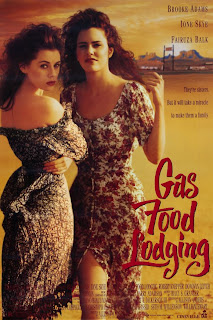
Gas Food Lodging: 1992
Starring Brooke Adams, Ione Skye, Fairuza Balk, and James Brolin
Imagine “The Last Picture Show” shot in color and shaped by a rueful feminine perspective, in a place where women are hopelessly anchored while the men drift through like tumbleweed. The becalmed town of Laramie, N.M., is the setting in which Nora (Brooke Adams), a hard-working waitress with a knowing, generous grin, has tried to bring up her two unruly daughters.

Starring Angel Aviles, Seidy Lopez, Devine, Monica Lutton, and Christina Solis
In “Mi Vida Loca My Crazy Life,” Allison Anders tries what few directors would have had the interest or intelligence to think of. She looks beyond the surface of the lives of Hispanic girl gangs and attempts to create a deeper portrait of young women in the Echo Park section of Los Angeles. They use gang names, like Sad Girl, Mousie and Whisper. And though violence is part of their lives, they are likely to be teen-age mothers struggling to get by.

Starring Sammi Davis, Valeria Golino, Madonna, Ione Skye, and Lily Taylor
The story—what little there is—revolves around a witches’ coven trying to resurrect the spirit of a stripper. All the ingredients (mother’s milk, virgin’s blood, sweat of five men’s thighs, and a year’s tears) are ready except for a sperm sample. Since witch Eva (Ione Skye) failed in her assignment to bring this vital component of the mixture, she is charged with seducing Ted and getting what she needs from him.
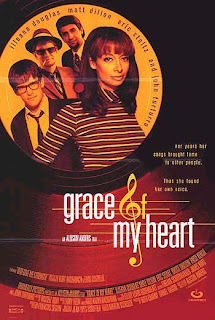
Starring Illeana Douglas, Sissy Boyd, Christina Pickles, and Jill Sobule
Loosely inspired by the life of Carole King, this is a light, feminist take on 15 years of pop: hits and Ms, if you will. It begins with a bright, peppy tone, pastiching the nascent rock’n’roll scene with an affectionate smile and perfect pitch—the Larry Klein-produced soundtrack is spot on. But it’s not all kitsch nostalgia: the period coincides with great social changes, particularly regarding the role of women, a recurrent Anders theme. Sharp cameos include Patsy Kensit’s rival songwriter and Bridget Fonda’s teen songbird with a secret love.

Starring Jade Gordon, John Taylor, Michael Des Barres, and Martin Kemp
It isn’t easy growing old in the land of youth and beauty. It’s even harder if you’re a rock-and-roller who hasn’t had a hit in decades, or a sexy leading lady now being offered parts as Christina Ricci’s mother. “Sugar Town,” an agreeably scruffy L.A. satire co-written and directed by Allison Anders and Kurt Voss, is filled with sharp, funny snapshots of the hustlers, has-beens, recovering junkies and Topanga Canyon earth mothers on the fringes of the Hollywood music biz.

